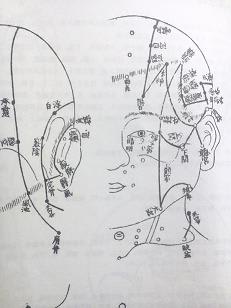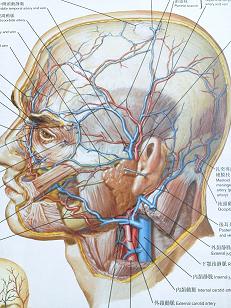鍼灸の患者さんに、耳鳴りや難聴に苦しむ方がいます。何カ月や何年か耳鼻科などに通い、それでも改善しないので鍼灸院に来られるのですが、驚くほど簡単に治ってしまうケースがあるのです。これらは、耳およびその周辺の感染や器質的疾患はなく、原因不明と言われる耳鳴り・難聴であり、突発性難聴とも呼ばれるものですが、なぜ治るのでしょう。その前に、耳鳴り・難聴について『メルクマニュアル』から見てみましょう。
ここから引用
耳鳴
耳鳴とは耳内の雑音であり,人口の10~15%が経験する。自覚的耳鳴は,音刺激の非存在下における音の知覚であり,患者にしか聞こえない。他覚的耳鳴は,耳の近くの血管組織から生じる音に起因し,症例によっては試験者にも聞こえる。
耳鳴は,ビービー,りんりん,ごーごー,ヒューヒュー,しゅーしゅーなどと表現され,ときには変化を伴う複雑な音である。それは断続的,持続的,あるいは拍動性(心拍に同調する)のことがある。持続的な耳鳴は,ごく軽い場合でもいらいらするものであり,しばしば大きな苦痛となる。一部の患者は他の患者に比べて耳鳴の存在によく順応し,ときとして抑うつを招く。ストレスは一般的に耳鳴を悪化させる。
病因
自覚的耳鳴は,ほとんど全ての耳疾患に伴って起こりうる。一般的な原因としては,音響外傷(騒音性感音難聴),その他の原因による感音難聴,耳垢や異物による外耳道の閉塞,感染(外耳炎,鼓膜炎,中耳炎,内耳炎,錐体尖炎,梅毒,髄膜炎),耳管狭窄などがある。高用量のサリチル酸塩は可逆性の耳鳴を引き起こすことがある。アミノ配糖体系抗生物質および一部の化学療法薬(例,シスプラチン)は難聴を引き起こすことがあり,耳鳴を伴う場合もある。
他覚的耳鳴は,拍動性のぶんぶんという可聴音を伴うまれな症状であり,頸動脈または頸静脈の乱流により引き起こされる可能性がある。血管に富む中耳腫瘍(例,鼓室型グロムス腫瘍や頸静脈型グロムス腫瘍)および硬膜動静脈奇形(AVM)も他覚的耳鳴を引き起こすことがある。
評価
病歴
発症前に大きな音または特定の薬物に暴露した場合,それぞれ音響外傷または聴器毒が疑われる。片側性の耳鳴は,特に難聴を伴う場合,聴神経腫瘍の可能性を示唆しうる。急性で片側性の難聴およびめまいは,特に気圧性外傷の後に生じた場合,外リンパ瘻を示唆しうる。反復性耳鳴,耳閉感,重度のめまい,変動性または永続的な難聴が同側の耳に生じる場合,メニエール病が疑われる(内耳障害: メニエール病を参照 )。
身体診察
頸部聴診時の雑音や静脈コマ音は,血管性の病因を示唆する。先がオリーブ形の聴診器または電子聴診器を用いた耳の聴診でのみ聴取される雑音は,硬膜AVMを示唆する。
検査
聴力検査を行い,もし難聴が認められれば,伝音,内耳性,後迷路性の難聴を鑑別する検査を行う(難聴: 聴覚検査を参照 )。ガドリニウム造影MRIにより,片側性耳鳴の症例で,特に難聴がある場合に,聴神経腫瘍が除外される。その他の検査は患者の症状に応じて実施する。片側性で拍動性の他覚的耳鳴では,動脈造影による頸動脈および椎骨動脈系の検査が必要な場合がある。このような場合には,動脈造影のリスクと,可能性のある硬膜AVMの検出および治療(塞栓形成法による)がもたらしうる利益とを比較検討しなければならない。磁気共鳴血管造影はおそらく,大部分の硬膜AVMを検出できるほど感度が高くはない。
治療
基礎疾患の治療により,耳鳴が改善することがある。難聴を治療すれば(例,補聴器で),約50%の患者で耳鳴が緩和される。症例によっては,抑うつを認識し治療することで耳鳴が緩和され,心理学的要素が示唆される。しかしながら,心理的原因を想定するべきではない。
特異的な内科的または外科的治療法はないものの,多くの患者は背景音があると耳鳴が遮蔽され,寝つきがよくなると感じる。耳鳴マスカーが効果のある患者もあるが,これは補聴器のように装用する器具で,耳鳴を抑制できる小さな音を流すものである。人工内耳のように内耳に電気的刺激を与えると,ときとして耳鳴が軽減されるが,これは重度難聴の患者に対してのみ適応である。
最終改訂月 2005年11月
http://merckmanual.jp/mmpej/sec08/ch084/ch084d.html
引用おわり
耳に疾患があれば、たいてい耳鳴りが起こります。しかし、耳鳴りがあれば耳に疾患があるとは言えません。二日酔いや高速エレベーター、飛行機などで耳鳴りが起きる人もいます。また、耳の疾患が治癒した後、あるいは何の疾患もなく、思い当たる原因もなく耳鳴り・難聴がある場合があり、音に関してだからといって耳に要因があるとは言えないのです。では他に何があるのでしょう。ちょっと、一つの症例を見てみましょう。
20代の女性で、3か月前から突然右耳だけが難聴になり、低音の耳鳴りがある。耳鼻科に通っていたが、外耳・中耳とも疾患もなく、感染症も起こしていない。仕事も家庭も問題なく、ストレスの自覚はない。睡眠もよくとれて、食欲も十分ある。肩こりで耳鳴りが起きるとインターネットで見て、鍼灸が効くらしいと聞き、来院された。
原因が分からないと言って、なんでもストレスのせいにしても問題を解決できません。ひと通り問診を済ませ、鍼治療を行いながら、さりげなく質問しました。
「今も耳鳴りは聞こえていますか?」
「はい」
「どんな音です?」
「低いブーンという音です」
「他に何か聞こえますか?」
「いいえ、何も聞こえません」
「そういえば、音楽が流れているの聞こえますか?」
「えー、あ、聞こえます」
「何の曲か分かります?」
「あれ、ピノキオの星に願いをですよね」
「そうそう、他には何か聞こえます?」
「いえ、別に何も」
「時計の針の音はどうです?」
「あ、聞こえます」
「いくつ聞こえます?」
「ひとつ・・・?」
「実はこの部屋には三つ時計があります。そのうち、だんだん聞こえてくるかもしれませんね」
とは言っても、三つの時計の音を判別して聞くのは耳のよい人でも結構大変です。そんな感じで一回目の治療を終え、一週間後に来院された時には、耳鳴りは消失していました。難聴の方も、音の聞こえやすさ、左右のバランスが少し右が悪いくらいで、人との会話では聞き返すことがなくなっていました。二回目の治療の後は、たまに低音が聞こえる程度になっており、三回目の治療後では耳鳴り・難聴とも完全に消失し、その後、一カ月経っても再発しませんでした。
では、このケースは何を意味しているのでしょうか。ほんの短い時間の中で起こった意識の方向の変化が観えますね。エトムント・フッサールは、意識とは常に何かに向けての意識である、と言いました。それを「意識の志向性」と呼びますが、これは誰にでもある心の働きなのです。
人ごみの中で、なぜか好きな人や自分の子供はすぐに見つけられる。騒音の中でも、自分の名前は呼ばれると分かる。耳が遠いのに悪口は聞こえる人。いろいろありますね。夜中、水道の蛇口から滴り落ちる水の音、時計の針の音、風の音や、近所の人の話し声などで寝付けなかったりすることはありませんか。いつもは全然聞こえないのに、なぜこの時それが聞こえるのか。原因は判らないでしょう。
この症例の女性には、これが起こっていた可能性があったのです。音というのは耳で聞くのではなく、耳を通して心で聞くものです。なので治療は意識の方向を変えてあげること。鍼の治療をしながら、さりげなく。あるいは鍼なしで、ただそれだけでもよかったのかもしれません。必要なのは適切な言葉です。
言葉には不思議な働きがあります。昔の人は、日本は言霊の幸はふ国、言霊の祐くる国、と言いました。今の人も、本心から信じてはいないにせよ、習慣的に世間的に忌み言葉をさけますね。とくに結婚式の時や受験生の前でとか。
病気の治療においても、もっと言霊を利用してもいいかもしれませんね。言葉を変えれば人の心が変わります。そして世界の中に存在する人の心が変われば、世界が変わるのです。
(ムガク)
ここで、どんな鍼灸の治療を行ったのか、どんなツボを使ったのか気になるという人もいると思いますが、それも意識の志向性が関係していますね。












